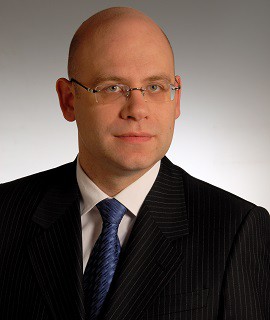With a clear long-term focus and very selective and active management, Alan Muschott manages the Franklin Global Convertibles fund, the largest strategy for active management of convertible bonds in the United States. In this interview with Funds Society, Muschott explains the assets’ advantages.
Why can convertibles work well in this market environment? What characteristics does this environment have that are positive for the asset?
In our view, convertibles can be attractive during various types of market environments, including rising markets, due to the potential asymmetric price relationship with the underlying common stock. Often called “balanced” convertibles, those with deltas (a measure of their equity sensitivity) near the middle of the range from 0.0 to 1.0 can participate more with an issuer’s equity upside than they do with the downside. These are the types of convertibles we prefer, as we feel this is the most appealing aspect of the asset class. We believe this ability to adapt to a myriad market conditions can make convertibles an attractive vehicle for increasing a portfolio’s level of diversification.
Why can convertibles work well in an environment of rate increases? Are you protected against the interest rate risk?
Amid expectations that US interest rate increases could accelerate, many fixed income investors in particular have asked for our view on the prospects for convertible securities. It’s an understandable concern as bonds tend to lose value when interest rates rise. In our research, during prior periods of rising interest rates, convertibles have historically performed better than 10-year US Treasuries. Therefore, in a rising-rate environment, we think convertibles can be a favorable place for fixed income investors to be. That said, it’s a bit incomplete to compare the performance of convertibles to other fixed income investments given their characteristics. Convertibles are a unique asset class, offering investors features associated with bonds and the growth potential of common stocks.
Convertibles are generally structured as a form of debt (bonds, debentures) or preferred shares with an embedded option that allows conversion into common shares under predetermined conditions. That embedded conversion option provides capital appreciation when the underlying common stock rises. In a rising-rate environment where interest rates are rising for the “right” reasons—for example, strong economic and corporate earnings growth—equities tend to perform well. If the underlying common stock in a convertible security rises with the market, the convertible should also increase in value because of the conversion option.
Historically, convertibles typically have exhibited a low correlation to fixed income and demonstrated imperfect correlation with stocks. This creates the potential for an investor to help enhance portfolio diversification, dampen volatility and improve a portfolio’s overall risk profile. Note, diversification does not guarantee profit nor protect against risk of loss.
What do you expect from the central banks? It seems that the measures for the monetary restriction have stopped… how do you value it?
Many central banks have tempered growth expectations in recent weeks in the midst of continued uncertainties stemming from geopolitical factors and other regional challenges which weigh on economic sentiment. Within the US, the Federal Reserve has also indicated a more patient approach to future rate hikes in the current subdued inflation environment.
We don’t manage our strategy based on expectations of monetary policy shifts or other macro variables. Instead we evaluate investments on the basis of the fundamentals of the companies themselves, their respective industry growth profiles and competitive positioning. Our focus is on identifying investments which we believe offer long-term prospects for capital appreciation; by investing in convertibles, we aim to capture an attractive amount of the equity upside while mitigating downside risk, thus generating compelling risk-adjusted returns over time.
Why is volatility good for convertibles? How does it help the behavior of the asset?
Since the US stock market selloff in the fourth quarter of 2018, many investors have asked us how convertible securities performed during the upheaval. Issued by companies looking to raise capital, these hybrid investments are generally structured as some form of debt or preferred shares with an embedded option that allows conversion into common shares under predetermined conditions.
According to our analysis, convertible securities generally outperformed their underlying stocks during the fourth quarter when the US equity market saw its steepest declines. That’s no surprise to us considering that convertibles have tended to perform well during periods of above-average market volatility. Since the beginning of 2019, as markets have moved higher, so have convertibles, broadly speaking, given their performance link to the underlying equity prices. During periods where the overall stock market is declining, the fixed income component in convertible securities tends to provide some protection against erosion of value. Conversely, when a company’s common stock rises, the convertible security should participate in the rise in value because of the conversion option. As long-term investors, our overall view on convertible securities doesn’t change from quarter to quarter or during periods of market volatility.
Now, is it better to invest in a protection component and less exposure in the equity component, or just the opposite?
Ultimately, orienting toward protection or equity should be driven by an investor’s needs in the context of their specific investment goals. It is fair to say that our Fund is oriented to the equity component. Our view is that a company’s underlying equity appreciation will drive returns in the convertible. Generally speaking, convertibles do not increase as rapidly in value as stocks during rising markets; nor does their downside protection equal that of bonds during market declines. However, historically they have delivered attractive long-term risk-adjusted returns compared with both stocks and bonds.
In the asset class, which markets do you favor by geographies, sectors…etc?
With a focus on balanced convertibles, those that tend to demonstrate asymmetric reward/risk profiles relative to other segments of the convertible bond market, our strategy seeks to participate in more of a company’s underlying equity price appreciation than depreciation. Interestingly, many balanced convertibles can be found in the North American market, in growth-oriented industries, and across market capitalizations.
The average life of a convertible security is about five years before it converts, and we often will hold a convertible to maturity, regardless of market gyrations in the interim. We spend a great deal of time on fundamental research, as we take a long-term approach to our investments. We seek to differentiate ourselves from others in the market through our security selection.
Key themes that we have identified for inclusion in our portfolio are related to secular growth in areas like technology, health care, and consumer discretionary spending. We see technology as increasingly becoming a non-discretionary expense for a wide range of companies and industries. In particular, we like certain convertible securities within themes like on-demand software. Many companies often lack the expertise, personnel and resources to develop this technology in-house, which creates opportunities for firms in the cloud computing and software-as-a-service areas.
Elsewhere we continue to see opportunities among companies showing high levels of innovation in the health care space. With accommodating regulators and novel new drug delivery methods and targets, we see a continuing wave of innovation in the health space. These are sectors that have performed well in the equity markets and which have, in turn, contributed to the returns we’ve generated within our Fund.
How is the market in terms of supply? Will there be new issues this year or is the relationship between supply and demand adjusted?
With a value of over US$300 billion at the end of 2018, the global convertible securities market is a sizeable player in the world’s capital markets. The United States accounts for over half that amount, followed by the Europe, Middle East, Africa (EMEA) and Asia-Pacific regions, respectively. Perhaps more important is the ample room for growth.
Following a peak in 2007, issuance declined through 2011 as companies took advantage of low yields, a high equity risk premium relative to credit spreads and strong flows into the credit markets to issue straight debt rather than convertibles. The perception was that raising capital through straight debt was relatively cheap, even when convertible securities were issued at slightly lower rates due to the added concern of share dilution. Companies were also hesitant to issue convertible securities as equity valuations were inexpensive relative to historical levels.
Over the last few years, more robust issuance trends have been driven by better equity market performance, a rise in interest rates and higher spreads. Thus far in 2019, we’ve seen solid issuance trends as well. We believe the factors that drive convertibles issuance, particularly those related to cost-effective financing (lower cost than straight debt; equity valuations at robust levels for many issues), can continue to support a healthy marketplace for convertibles.
What returns can be expected from the asset in 2019?
Our approach is long-term in nature and we typically hold our securities for much of their (on average) five-year maturities; thus we don’t generally make predictions of price returns over calendar year periods. Our outlook for equities continues to be positive. We believe earnings growth can support further price appreciation from today’s levels in a number of equity sectors.
We do believe it’s important to be selective. As a group, convertibles have historically presented an attractive risk/reward profile, but within the group there is considerable variation in the level of risk, sensitivity to movements in the underlying stock, and upside participation potential. Because of this, we believe active management is an important element within convertibles investing.
In your fund, what is the selection criteria that you follow? How many names do you invest in? What is the delta of the portfolio? Please comment on the main characteristics of the fund
The Franklin Convertible Securities Team have utilized convertible securities to various degrees across a number of strategies throughout the years. We seek to take advantage of the compelling, asymmetric risk/reward profile offered by balanced convertibles. Balanced convertibles are those securities that tend to offer greater upside participation than downside potential, leading to an asymmetric return profile.
As a global firm with deep experience across asset classes, styles, and regions, Franklin Templeton possesses a strong potential to develop what we believe to be unparalleled insights in the convertibles market. Equity and credit research analysts usually meet with company management, then build valuation models and form an opinion of an issuer regardless of whether they have outstanding convertibles. Our portfolio managers continuously monitor the convertibles market and new issuance trends. When the team sees a new company come to market, they are typically already familiar with these businesses, their equity potential, and credit metrics.
We seek to offer pure convertibles exposure. We don’t buy common stock, and in case of conversion, seek to sell equity in our portfolio as soon as an attractive exit point presents itself. One can expect our portfolio delta to fall in the range of balanced convertibles (0.4-0.8); we will typically have 60-80 issues within the Fund; our preference is to reasonably equal-weight our holdings so that each has an opportunity to have impact on portfolio performance. Our credit quality, market cap, regional and sector exposures will typically reflect what we see in the broader balanced convertibles universe; where we seek to differentiate ourselves and the portfolio’s returns is through security selection.



